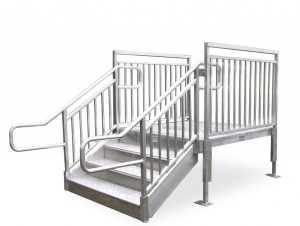At REDD Team, we understand that nothing could be more critical for you than the productivity and safety of your workplace, educational institution, commercial premise, or municipal enterprise. That is why we strive to offer our clients quality OSHA-compliant access stairs to improve safety. Our access stairs are applicable across multiple industries.
Stair Access Compliance
 As a building owner, the responsibility of ensuring safety for all occupants of your building rests squarely on your shoulders. All REDD Team access stairs comply with OSHA standards that cover stairways in educational, industrial, commercial, and military premises. OSHA-compliant access stairs must have fall protection and falling object protection, including guards and handrails.
As a building owner, the responsibility of ensuring safety for all occupants of your building rests squarely on your shoulders. All REDD Team access stairs comply with OSHA standards that cover stairways in educational, industrial, commercial, and military premises. OSHA-compliant access stairs must have fall protection and falling object protection, including guards and handrails.
There are multiple compliance standards for access stairs, including OSHA and IBC. Specific OSHA access stair requirements include tread depth, tread nosing, riser height, and stair landings. For specific details about OSHA compliance for access stairs, please refer to the OSHA website.
OSHA vs. IBC Stairs
The design and construction of access stairs in the U.S. are carefully considered because each feature has to meet specific standards before being available for use. Access stairs can be designed to comply with varying regulations depending on their installation location. Multiple regulatory agencies, including IBC and OSHA, determine the standards for access stairs for commercial, military, educational, and industrial settings. Some building owners find it difficult to know which standards to follow.
Access Stairs for the General Public
The International Building Code (IBC) determines the standards for stairs used in public facilities, including all stairways connecting buildings to public spaces. The standards accommodate the access requirements for different people, including children and the elderly.
The IBC requires access stairs with an occupant load of fewer than 50 people to be no less than 36 inches wide. The landing and stairs must have similar widths and be three feet long. In addition, the regulatory agency requires access stairs higher than 12 feet tall to have an intermediate landing in the middle of the stairs.
Access stairs are also required to have handrails and guards. In addition, the gaps between the handrails and guards in open-sided access stairs must not be more than four inches wide. This safety standard ensures children’s heads cannot pass through the open sections of the stairs, including the landing and platform.
IBC standards also determine the rise and tread measurements for the individual steps. Rise refers to the vertical height between adjacent steps, which could be open or closed. On the other hand, tread refers to the depth of the step. According to the IBC, access stairs must have closed risers of between four and seven inches and a tread exceeding 11 inches deep. If your commercial, industrial, educational, or commercial premise is open to the public, all access stairs must comply with IBC guidelines.
Access Stairs for Private Use
Many commercial and industrial premises have private facilities that are not open to the public. Such facilities include factory floors and other spaces designated explicitly for employees to work. The access stair requirements for such premises are bound by the Occupational Safety and Health Administration (OSHA).
All REDD Team access stairs have unique features that make them OSHA compliant. Our access stairs are durable and robust, and they come with guards and handrails. These access stairs can be used in multiple locations, including educational, industrial, commercial and military installations.
REDD Team is the go-to company for quality OSHA-compliant access stairs. Visit our store online to learn more about our accessibility products.

